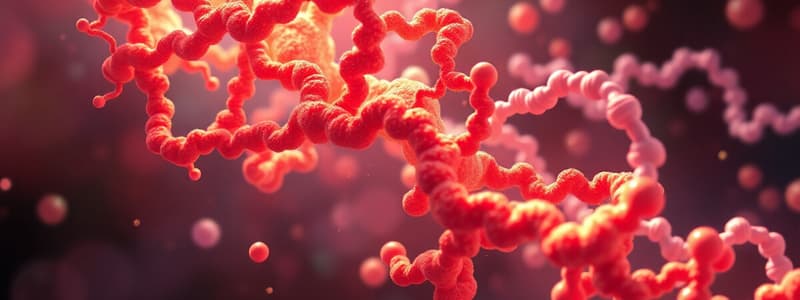Podcast
Questions and Answers
What are the macromolecules that are considered polymers? What is an example of a non-polymeric chained macromolecule? What's the distinction?
What are the macromolecules that are considered polymers? What is an example of a non-polymeric chained macromolecule? What's the distinction?
Proteins, nucleic acids, carbohydrates, and lipids. Lipids are not polymers because they are not formed from repeating monomer units. Polymers are chains of repeating monomer units, while non-polymers are not.
What are the 9 main functions (classes) of proteins?
What are the 9 main functions (classes) of proteins?
Enzymes, structural proteins, storage proteins, transport proteins, hormonal proteins, receptor proteins, contractile and motor proteins, defensive proteins, and toxins.
Draw by hand from scratch the common structure that all amino acids share, using “R” in your picture to generically represent the side chain.
Draw by hand from scratch the common structure that all amino acids share, using “R” in your picture to generically represent the side chain.
The common structure includes a central carbon atom bonded to an amino group (-NH2), a carboxyl group (-COOH), a hydrogen atom (-H), and an R-group (side chain).
How can you identify all 20 amino acid side chains if shown to you as a stick-figure molecule?
How can you identify all 20 amino acid side chains if shown to you as a stick-figure molecule?
How can you determine whether an amino acid is polar/nonpolar, charged/uncharged, hydrophilic/hydrophobic?
How can you determine whether an amino acid is polar/nonpolar, charged/uncharged, hydrophilic/hydrophobic?
What are the 3 letter and 1 letter abbreviations used for amino acids?
What are the 3 letter and 1 letter abbreviations used for amino acids?
What are peptide bonds? Which parts of the amino acid molecule participate in adding to the elongating polypeptide backbone?
What are peptide bonds? Which parts of the amino acid molecule participate in adding to the elongating polypeptide backbone?
When do we call an amino acid a “residue”? Why is this name appropriate?
When do we call an amino acid a “residue”? Why is this name appropriate?
When a folded protein is shown as a squiggly line drawing, what does this represent? What parts are omitted for clarity?
When a folded protein is shown as a squiggly line drawing, what does this represent? What parts are omitted for clarity?
What are the four types of side chain-to-side chain bonds involved in protein folding? Why are some stronger than others?
What are the four types of side chain-to-side chain bonds involved in protein folding? Why are some stronger than others?
Understand what is meant by the Primary, Secondary, Tertiary, and (sometimes) Quaternary structure of proteins.
Understand what is meant by the Primary, Secondary, Tertiary, and (sometimes) Quaternary structure of proteins.
Flashcards
Macromolecules that are polymers
Macromolecules that are polymers
Large molecules made of repeating structural units, like proteins and carbohydrates.
Example of non-polymeric macromolecule
Example of non-polymeric macromolecule
Lipids are macromolecules that do not form polymers.
Functions of proteins
Functions of proteins
Proteins serve 9 main functions, including enzymes, structural support, and transport.
Common structure of amino acids
Common structure of amino acids
Signup and view all the flashcards
Identify amino acid side chains
Identify amino acid side chains
Signup and view all the flashcards
Amino acid properties
Amino acid properties
Signup and view all the flashcards
Amino acid abbreviations
Amino acid abbreviations
Signup and view all the flashcards
Peptide bonds
Peptide bonds
Signup and view all the flashcards
Amino acid 'residue'
Amino acid 'residue'
Signup and view all the flashcards
Folded protein representation
Folded protein representation
Signup and view all the flashcards
Protein folding bonds
Protein folding bonds
Signup and view all the flashcards
Primary protein structure
Primary protein structure
Signup and view all the flashcards
Secondary protein structure
Secondary protein structure
Signup and view all the flashcards
Tertiary protein structure
Tertiary protein structure
Signup and view all the flashcards
Quaternary protein structure
Quaternary protein structure
Signup and view all the flashcards
Hydrophilic vs. Hydrophobic
Hydrophilic vs. Hydrophobic
Signup and view all the flashcards
Charged vs. Uncharged amino acids
Charged vs. Uncharged amino acids
Signup and view all the flashcards
Amino group
Amino group
Signup and view all the flashcards
Carboxyl group
Carboxyl group
Signup and view all the flashcards
Study Notes
Introduction to Proteins
- Macromolecules are considered polymers. A non-polymeric example is a non-polymer chained macromolecule.
- Proteins have 9 main functions.
- Draw the common structure of all amino acids, using an "R" to represent the side chain.
- Identify all 20 amino acid side chains by sight from stick-figure molecules.
- Determine if an amino acid is polar/nonpolar, charged/uncharged, hydrophilic/hydrophobic.
- Memorize 3 and 1 letter abbreviations for amino acids.
- Peptide bonds are between parts of amino acids for the polypeptide backbone.
- "Residue" is the term for an amino acid when adding to a polypeptide backbone.
- Folded proteins are usually shown as squiggly lines omitting side chains.
- Protein folding involves 4 types of side chain-to-side chain bonds of varying strength.
- Primary, Secondary, Tertiary, and (sometimes) Quaternary structures are involved in protein folding.
Studying That Suits You
Use AI to generate personalized quizzes and flashcards to suit your learning preferences.




